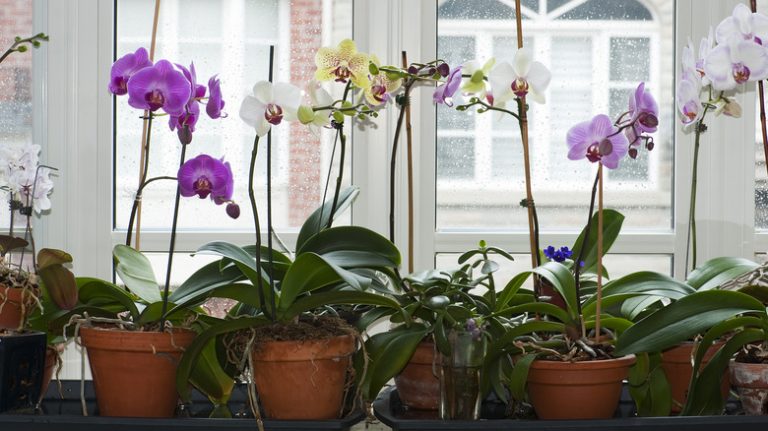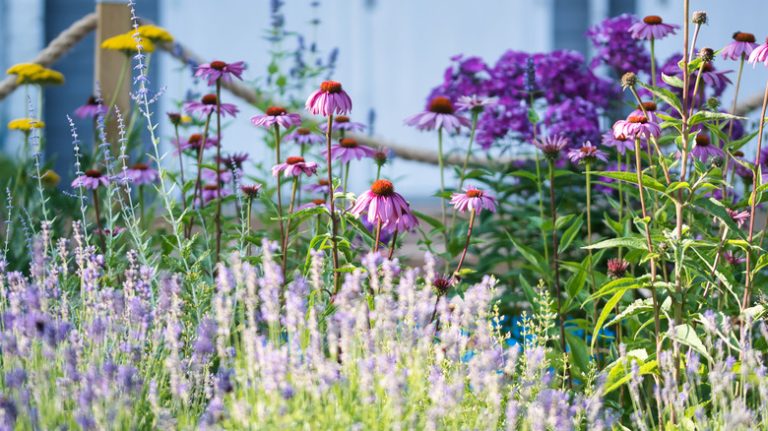If you’re looking for a quick way to attract bees and other pollinators to your garden, consider sowing the Rocky Mountain Bee Plant. This useful plant, also known as Cleome serrulata or beeplant, is native to North America and can be found across Minnesota, Montana, and other parts of the United States.
The Rocky Mountain Bee Plant is a flowering beauty that not only adds a splash of color to your garden but also serves as a source of food for bees and other beneficial insects. Its tall stalks, which can reach up to six feet in height, are adorned with clusters of vibrant pink or white flowers that emit a sweet, honey-like odor. These flowers are rich in nectar and pollen, making them a favorite among bees.
The plant’s foliage is also worth noting. Its lobed leaves are green and lush, making for an attractive addition to any garden. The Rocky Mountain Bee Plant is versatile when it comes to soil type and can tolerate poor, well-draining soils. It prefers full sun but can also tolerate partial shade.
While the name “Rocky Mountain Bee Plant” may suggest that it only grows in mountainous regions, this is not the case. It can thrive in a variety of climates across North America, from the cold winters of Minnesota to the hot, dry summers of Montana. It is a hardy plant that can survive temperatures as low as -30°F (-34°C) and as high as 100°F (38°C).
When sowing the Rocky Mountain Bee Plant, it’s important to choose a location that receives plenty of water and allows for good drainage. The plant does not tolerate overly wet or waterlogged soils, so be sure to water it sparingly. Avoid overwatering, as this can lead to root rot and other diseases.
Propagation of the Rocky Mountain Bee Plant can be done either by seeds or by cuttings. The seeds are easy to collect and can be sown directly into the garden in early spring. The plant can also be grown from cuttings taken in late summer or early fall. Detailed instructions on sowing and propagation can be found on various online sources.
It’s worth noting that the Rocky Mountain Bee Plant can be invasive in some areas, so it’s important to check with local authorities before planting it. In regions where it is not considered invasive, however, the plant can be a wonderful addition to any garden. Its long flowering season, from early summer to early winter, ensures that it will be a source of beauty and food for pollinators all year round.
The Rocky Mountain Bee Plant is a popular choice among gardeners and bee enthusiasts alike. Its ability to attract bees and other pollinators makes it an important plant for supporting our ecosystem. So why not create your own pollinator palace by planting the Rocky Mountain Bee Plant in your garden?
If you have any questions or comments about growing the Rocky Mountain Bee Plant or other wildflowers, feel free to leave them below. Our team of garden experts is here to help!
What Is A Rocky Mountain Bee Plant – Learn About Rocky Mountain Cleome Care
The Rocky Mountain bee plant, also known as Rocky Mountain cleome, is a fascinating plant that attracts a wide variety of pollinators. Native to western North America, it is often used in gardens and restoration projects to provide a valuable food source for bees, butterflies, and other beneficial insects.
This perennial plant can reach heights of up to 5 feet and has long, slender stems with small yellow-green flowers. The flowers develop into unique seed pods, which resemble bee hives. These seed pods contain black seeds that can be collected and used for future plantings.
One of the interesting things about the Rocky Mountain bee plant is that it has a close relationship with native American tribes. It was used by the Lewis and Clark expedition for food and medicine, and today it is still an important plant for many indigenous communities.
When it comes to caring for Rocky Mountain cleome, it is a relatively low-maintenance plant. It prefers well-draining soil and can tolerate poor soil conditions. It is important to avoid overwatering, as this can lead to root rot. Watering the plants once a week is usually sufficient, unless there is a period of heavy rainfall or high temperatures.
Fertilizing is not usually necessary, as the plant can thrive in poor soil. However, if you notice poor growth or small shoots, a light application of a balanced fertilizer can help. Be sure to follow the instructions on the fertilizer package and only apply it during the growing season.
In terms of pests and diseases, the Rocky Mountain bee plant is relatively resistant. However, if you notice any problems, such as aphids or powdery mildew, you can use organic pest control methods or consult with a professional for advice.
If you are considering planting the Rocky Mountain bee plant in your garden or restoration project, it is important to source your plants from reputable sources. Avoid collecting seeds or plants from weedy populations, as they may be invasive and cause problems in your area.
To learn more about the Rocky Mountain bee plant and its care, you can visit several online resources or ask local gardening services for information. Additionally, there are plenty of books and articles available that provide detailed information on growing and caring for this unique plant.
If you are still unsure about whether the Rocky Mountain bee plant is right for your garden, it can be helpful to visit gardens or nature preserves that feature this plant. Observing it in its natural habitat can give you a better idea of its growth habits, its ability to attract pollinators, and its overall appearance.
In summary, the Rocky Mountain bee plant is a valuable addition to any garden or restoration project. Its long stems, unique seed pods, and ability to attract pollinators make it a standout plant. With proper care and attention, you can enjoy the beauty and benefits of this plant for many years to come.
What is a Rocky Mountain Bee Plant?
The Rocky Mountain Bee Plant, scientific name Cleome serrulata, is a flowering plant that is native to North America. It is also known by other names such as beeplant, spider flower, and stinking clover. The plant is commonly found in the western part of the United States, particularly in the Rocky Mountains region.
The Rocky Mountain Bee Plant is highly valued for its role as a pollinator plant. It attracts a variety of pollinators, including bees, butterflies, and hummingbirds, with its vibrant pink flowers and nectar. The plant is often used in habitat restoration projects to help support and attract pollinators.
While the Rocky Mountain Bee Plant can reach a height of up to 5 feet, it typically only grows to about 1-3 feet tall. The plant has a unique appearance with its long, thin stems and clusters of pink flowers. It prefers well-draining soil and requires regular watering, especially during dry periods. The plant is known to be somewhat invasive and can reseed itself if not properly maintained.
Propagation of the Rocky Mountain Bee Plant can be done by seed. The seeds of the plant require stratification, which is a process of mimicking the natural winter conditions in order to stimulate germination. It is recommended to start the seeds indoors before transplanting them outside. The seeds can be sown directly into the ground in the spring or fall.
- Light Requirements: Full sun
- Watering: Regular watering, especially during dry periods
- Soil: Well-draining soil
- Height: 1-3 feet
- Blooming Period: Summer
- Native to: North America, particularly the Rocky Mountains region
In terms of care and troubleshooting, the Rocky Mountain Bee Plant may sometimes attract pests such as aphids or spider mites. These can be controlled by using organic pesticides or by spraying the plant with a mixture of water and dish soap. Fertilizing the plant is not usually necessary, as it can thrive in poor soil conditions.
If you are in Minnesota, you can visit the Rocky Mountain Bee Plant at the Pollinator Palace located in Ramsey County. The Pollinator Palace is a small-scale botanical garden that features a variety of native plants and wildflowers, including the Rocky Mountain Bee Plant. It is a great place to learn more about these plants and their importance in supporting pollinators. Matt and Peter, who run the palace, are knowledgeable and can provide more information about the Rocky Mountain Bee Plant and other pollinator plants.
So, if you are interested in attracting pollinators to your garden or starting a habitat restoration project, the Rocky Mountain Bee Plant is definitely one to consider. Its easy propagation, quick flowering, and ability to attract a variety of pollinators make it a valuable addition to any landscape.
How to Grow Rocky Mountain Bee Plants
Growing Rocky Mountain Bee Plants, also known as Cleome serrulata, can be a fun and rewarding experience. These flowering plants are native to the rocky mountain regions of Montana and New Mexico and are a great addition to any pollinator garden. If you’re looking to attract bees and other pollinators to your garden, here’s what you need to know about growing Rocky Mountain Bee Plants.
1. Source Your Seeds
Start by sourcing your seeds from a reliable source. It’s important to obtain seeds from a reputable supplier to ensure you’re getting high-quality seeds that will grow into healthy plants.
2. Sowing the Seeds
Sow the Rocky Mountain Bee Plant seeds directly into your garden or start them indoors. If you choose to start them indoors, plant the seeds in small pots and keep them in a warm and sunny spot. Transplant the seedlings outdoors after the last frost.
3. Location and Sun Exposure
Rocky Mountain Bee Plants thrive in full sun but can tolerate some shade. Choose a location in your garden that receives at least 6 hours of direct sunlight each day.
4. Water and Humidity
These plants prefer moderate moisture levels and can tolerate dry conditions. Water them regularly, especially during dry spells, but avoid overwatering as it can cause root rot.
5. Care and Maintenance
Rocky Mountain Bee Plants require little care and maintenance once established. Remove any weeds or invasive plants that may compete for nutrients and water. Prune the stems if they become too long or crowded.
6. Fertilizing
These plants do not require much fertilizing. However, you can apply a balanced fertilizer once a month during the growing season to promote healthy growth.
7. Diseases and Pests
Rocky Mountain Bee Plants are generally disease-resistant and not prone to pest infestations. However, keep an eye out for spider mites and aphids, and treat them with an appropriate insecticide if necessary.
8. Attracting Pollinators
The flowers of the Rocky Mountain Bee Plant produce nectar that attracts bees, butterflies, and other pollinators. The plants also provide a habitat for beneficial insects. By growing these plants, you will create a pollinator palace and support the important work of these creatures.
9. Fruit and Seeds
If the flowers are pollinated, they will produce bean-like fruits containing seeds. These seeds can be collected and stored for future sowing or shared with other gardeners.
10. Useful Tips
Here are some useful tips when growing Rocky Mountain Bee Plants:
– Plant them in well-draining soil to avoid waterlogging.
– Deadhead the spent flowers to encourage continuous blooming.
– Rocky Mountain Bee Plants can self-seed, so be prepared for new plants to pop up across your garden.
– Some varieties of Rocky Mountain Bee Plants have hairy or hairless stems, so choose the one you prefer.
– Be wary of the odor; some people find the scent of the flowers unpleasant.
By following these steps, you can successfully grow Rocky Mountain Bee Plants and create a beautiful and vibrant pollinator garden. If you have any questions or need further assistance in growing these plants, don’t hesitate to seek advice from local gardening services or join online gardening communities where fellow gardeners can provide valuable insights.




